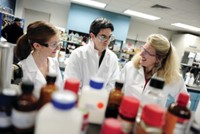Advertisement
Grab your lab coat. Let's get started
Welcome!
Welcome!
Create an account below to get 6 C&EN articles per month, receive newsletters and more - all free.
It seems this is your first time logging in online. Please enter the following information to continue.
As an ACS member you automatically get access to this site. All we need is few more details to create your reading experience.
Not you? Sign in with a different account.
Not you? Sign in with a different account.
ERROR 1
ERROR 1
ERROR 2
ERROR 2
ERROR 2
ERROR 2
ERROR 2
Password and Confirm password must match.
If you have an ACS member number, please enter it here so we can link this account to your membership. (optional)
ERROR 2
ACS values your privacy. By submitting your information, you are gaining access to C&EN and subscribing to our weekly newsletter. We use the information you provide to make your reading experience better, and we will never sell your data to third party members.
Careers
Where are the women?
January 15, 2007
| A version of this story appeared in
Volume 85, Issue 3
As a woman in chemistry, I have enjoyed reading articles in C&EN on equity for female scientists.
Inequities in the allotment of laboratory space, compensation, and representation in tenured faculty positions are some of the topics that have been addressed on these pages. A recent issue, in fact, includes a review of two books related to women in science, one of which is, "Are Women Achieving Equity in Chemistry?" (C&EN, Nov. 27, 2006, page 34). I would like to think that we are moving toward that goal.
On page 38, however, appears an announcement by the ACS Division of Organic Chemistry of fellowship awards to third- and fourth-year graduate students. Only one of 18 awards was given to a woman. We can do better than this. If we as ACS members support the advancement of women to leadership positions in academia, industry, or government, then we need to create opportunities for women early in their careers.
Let's work to fix the leaky pipeline.
Katherine Lee
West Newton, Mass.
As I was paging through the Nov. 27, 2006, issue of C&EN, the Awards section caught my attention. Among the photographs of the 18 recipients of the 2005-06 Organic Graduate Fellowships, I saw only one woman (5.6% representation). Reading the article more closely, I also discovered that only one of the 18 faculty advising these awardees was a woman. I must admit that I am often oblivious to unequal gender representation, but this disparity was so large that it was impossible to ignore.
Even though close to a third of Ph.D.s in chemistry are awarded to women, women do not appear to be receiving graduate fellowships and awards at the same rate as male graduate students. Over the past 25 years, receipt of the ACS Organic Graduate Fellowship has been a strong predictor of future success in academic chemistry, so the low representation of women is particularly alarming. Five years from now, will only 5.6% of assistant professors in organic chemistry be women?
Although the sample size is small, the fellowship recipient data suggest a systematic loss of women from the "academic pipeline" early in their graduate careers. Interestingly, not all scientific disciplines experience losses at this point the pipeline: In 2002, 16% of assistant professors of physics were women, showing essentially no loss from six years earlier when 17% of first-year physics graduate students were women.
Reading about the chemistry fellowships provoked me to think about possible reasons for losses in the chemistry pipeline. Are women less likely to join the labs that produce organic graduate fellows? Are they less likely to apply for the fellowship, either because of active discouragement or lack of encouragement? Are they less likely to seek critical advice on the content of their application? Is more overt gender discrimination at work? I suspect that I have not hit upon all the reasons, or even the most important ones, and I am writing this letter to encourage C&EN readers to give this issue serious consideration.
In evaluating the sources of this disparity and possible solutions, it may be instructive to consider the inaugural NIH Director's Pioneer Awards, where a similar gender imbalance was observed, albeit among faculty applicants and recipients. In the second year of the competition, NIH implemented specific policies aimed at eliminating gender bias at every stage in the application process. In that year, five of 13 Pioneer Awards went to women. Perhaps there are analogous policy changes that would help to prevent losses early in the chemistry pipeline.
Jennifer J. Kohler
Stanford, Calif.
What is wrong with this picture? C&EN published the Organic Graduate Fellows awards for 2005-06. The students are very impressive and congratulations to them all. But I was stunned when I realized that 17 of the 18 were men. The demographics of chemistry suggest that close to 50% of the graduate students today are women.
Why is it then that only 6% of the Organic Graduate Fellows are women? It is hard for me to believe that only one in 18 of "organic chemistry's brightest young scholars" are women. May I suggest that the nominators and selection committee reflect on this fact?
Richard Armstrong
Nashville




Join the conversation
Contact the reporter
Submit a Letter to the Editor for publication
Engage with us on Twitter